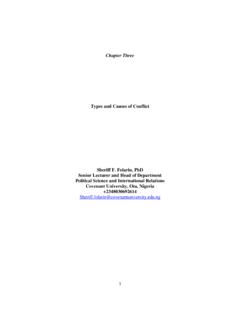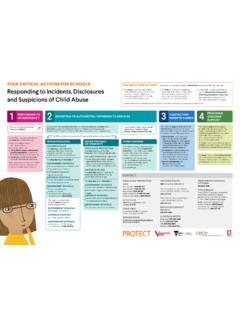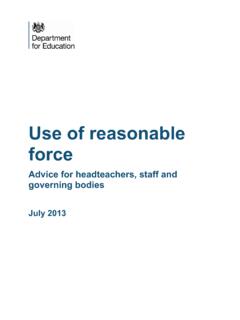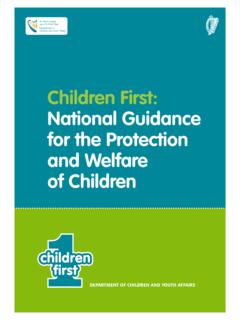Transcription of National Baseline Study on Violence against Children
1 National Baseline Study on Violence against Children : PhilippinesEXECUTIVE SUMMARYO ctober 2016 National Baseline Study on Violence against Children : PhilippinesExecutive SummaryCover photograph: UNICEF Philippines/2016/GCalveloDesign and layout: Beetlebugs Communications, Inc. Council for the Welfare of Children and UNICEF Philippines 2016 Any part of this document may be freely reproduced with appropriate ..iiAcknowledgment .. iiiList of Acronyms ..ivDefinitions ..vIntroduction .. 1 The Epidemiological Survey.
2 3 Profile of respondents .. 3 Physical Violence .. 4 Psychological Violence .. 5 Sexual Violence .. 6 Peer Violence .. 8 Cyber Violence .. 8 Collective Violence .. 9 Polyvictimization .. 9 Prevalence data by Socio Economic Status (SES), residence location, and gender .. 9 Respondents as perpetrators of Violence .. 10 Children in need of special protection .. 10 Consequences of VAC.
3 12 Disclosure, reporting and utilization of VAC services .. 12 Community Stakeholders Study .. 14 Stakeholders perceptions of VAC .. 14 Structure .. 14 Policies and programs .. 14 Budget ..14 NGOs/POs .. 15 Training of direct service providers in the child 15 Prevention readiness .. 15 Discussion of Results .. 17 High overall prevalence of Violence against Children .. 17 Low disclosures and reporting despite the high prevalence .. 19 LGUs generally have low capacity to prevent and respond to VAC.
4 19 Social norms: the acceptance and justification of Violence against women and Children .. 20 Addressing needs of Children in need of special protection .. 21 References .. 27 IIPrefaceViolence against Children (VAC) is a global problem; confronting every country in the world. Children are exposed to the threat of Violence in all spheres of life; at home, in school and the community, the workplace and in institutions. In all of these settings Children are exposed to various forms of Violence , including physical, emotional and sexual exploitation and abuse, as well as neglect.
5 New/emerging forms of Violence include online exploitation, where easy access to internet and the hidden nature of crimes committed in cyberspace leave Children particularly physical and emotional harm to Children resulting from the experience of Violence is devastating. The affect and impact on Children creates lasting emotional and psychological scars, as well as physical pain and suffering; the damage can last a lifetime. Victims may themselves become perpetrators of Violence as a result of their experiences.
6 The burden of Violence to society is enormous; the costs of health care, child welfare support services, as well as the increased costs to the criminal justice system when child victims are at an increased risk of becoming Children in conflict with the law. Finally, society also loses when abused Children are less able to contribute and become productive members of their The Philippines thousands of Children are robbed of their childhood, and suffer lifelong developmental challenges, as a result of Violence .
7 Impacts include both mental and physical health disorders, including anxiety, depression, cardiovascular disease, as well as health-risk behaviours including smoking, alcoholism, drug abuse and engagement in high risk sexual activity. Since 2007 when Swaziland conducted the first Violence against Children Survey (VACS) more than 20 countries, including the Philippines, have undertaken National surveys on VAC, thus contributing greater evidence and thus global and regional understanding of VAC research. The Philippine s commitment in 2010 to undertake its own National Study the first country in the region to begin this process follows the country s recognition as an active regional leader in the VAC movement.
8 In general, recently enacted laws and policies in the Philippines have been crafted to better protect Children , and adhere to international standards, and are thus held up as positive examples for the region. However, in spite of these laws, a dearth of National data and a lack of reporting mechanisms have rendered many less effective than intended. Consequently, initiatives taken by National institutions and international organizations are often insufficient, and at times even irrelevant and inappropriate.
9 Additionally, prosecutions and convictions of those who perpetrate VAC have remained disproportionately low, with little change over the years. The completion of the NBS-VAC marks a watershed moment in addressing these challenges and is widely recognized as a vital undertaking that will lead to a clearer and more accurate picture about the extent and magnitude of Violence against Filipino Children and youth. From the The Philippine National Baseline Study on Violence against Children : The Story Behind the Research VIIIA cknowledgmente would like to thank all the Children and their parents/guardians as well as the Local Government Units (LGUs) from the 172 municipalities, cities and barangays all over the country for participating in this Study .
10 We appreciate all your support and assistance in making this endeavour a success;To our VAC partners (GO s, NGO s, academia), for being with us throughout the years of planning and preparation, and for making sure that all these efforts will be translated into action - for the well-being of the Children , their families and communities in the UNICEF, Consuelo Zobel Algers Foundation and the Institute of Health Policy- National Institutes of Health, UP Manila for their generosity and commitment to make this country a live able place for Children .
















